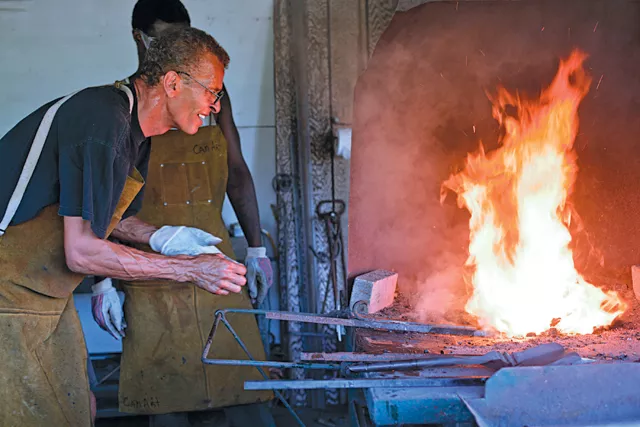Artist and restorer Carl Nielbock is giving us a tour of his live-work space near Eastern Market. He chatters nonstop in his German accent, guiding us from the first-floor loading area up through the second-floor workshop and design studio, where his plans for future projects adorn the walls. On one half-wall is a photograph of the building as it looked when he bought it, with its ceiling falling in. With his keen restorer's eye, Nielbock noted that the walls and foundation were sound, and now, several years later, it is the center of his activities. Finally, after having hardly taken a breath between words, he leads us up to his third-floor living quarters, where he seats himself on a luxurious couch, surrounded by what appear to be artworks and architectural ornaments from around the world.
But Nielbock is no new arrival, not one of the scores of artists who've claimed Detroit as their home in the last few years. Nielbock arrived almost 30 years ago, and his relationship with this city stretches back to his birth. In fact, his story contains unusual similarities to those who've grown up in Detroit, perhaps leading him to become a dogged advocate for the preservation of the art and heritage of his adopted hometown.
To understand Nielbock, you have to start at the beginning. Born in Lower Saxony in Germany in 1959, he was one of the "children of the occupation," with a German mother and an African-American GI father. Once the Army higher-ups found out about the interracial relationship, which was illegal in many parts of the United States at the time, his father was in deep trouble. The military made sure Carl never got a chance to meet his GI dad.
Until the 1980s, not much has been written about the experience of growing up Afro-German in postwar Germany, and little official study has been made of "occupation children" by the U.S. military. Estimates of children of mixed German and African-American heritage born after the Second World War range from 5,000 and up. Until the creation of the Afro-Deutsch movement in the 1980s, there were few organizations providing support dealing with the challenges of growing up different in largely homogeneous Germany, or assistance with locating missing or unknown fathers. For Nielbock, and others whose heritage was a mystery, there were few resources available at the time. "With the help of resources today, we can find anybody," he says. "But when I came [to Detroit], I was by myself with no recognition that people like me existed."
The German half of his heritage was less mysterious, but no less challenging, dealing with the general hardships of growing up in postwar Germany. To hear him describe it, the rebuilding that went on in Germany, as it was still being de-Nazified and integrated into the West, was a special time for a special people, whom he describes as "forward-looking," but gazing also deep into the past and "choosing which values to reject and which to sustain." To take ruined historic buildings and monuments and repair them for posterity was a natural and normal part of his upbringing, undertakings that present eerie parallels with the Detroit of today. Though Neilbock didn't take part in reconstruction of buildings, his trade had a deep connection to the past, as he apprenticed as a blacksmith. He says, "I didn't recognize it as a historical trade at the time, but it helped lay the foundation of doing historical, authentic work."
Of course, Lower Saxony was destroyed in a few years by Allied munitions, whereas Detroit's destruction has dragged on for decades, caused by disinvestment, ill-conceived "urban renewal" projects, arson, demolition sprees, drug epidemics, industrial pollution and crime, but the similarities are worth noting: two places recovering from destruction and now looking into the past to find historical heritage worth saving for the future.
After growing to adulthood, Nielbock was looking for some history of his own. In 1984, a 25-year-old Nielbock came to the east side of Detroit, finding a house at a return address on an old letter among his mother's possessions. Nobody was home, but, knocking at the house next door, he learned the house was used as storage, and that the man he was looking for lived down the street.
The man who lived down the street was Nielbock's father, Clarence Cheeks.
And the man Nielbock had spoken to was his uncle, Clarence's brother, Cecil Cheeks.
Reunited with his son, Clarence, who had a job as a city maintenance worker, let the young man take over the house on Helen Street, which had been used for storage. It took a lot of time and effort, but Nielbock took down all the molding and trim and rebuilt the house, using advice and tricks from his uncle Cecil, who worked as a carpenter and was accustomed to such old houses. Nielbock learned much in this new "apprenticeship," and fixed it up with the skill of a restorer, eventually adding a shop on the back of it.
Today, he laughs, thinking of how freaky the house must have looked, with him welding in his kitchen at 3 a.m., with bursts of white light shooting out of it.
In America, Nielbock prospered, working on metal architectural ornamentation for such governmental clients as the Library of Congress and the State Department. Getting these jobs was no small achievement, as he reels off a number of certifications he had to attain in order to do this sort of work. His clients also began to include the affluent, as he fabricated new wrought-iron and aluminum pieces for ostentatious homes, jobs on which money didn't matter. Using these profits, he was able to repair and move into the studio and living space he now occupies, near the intersection of Gratiot and Chene, headquarters of his company CAN Art Handworks, Inc. Under the CAN Art aegis, he worked rebuilding the Hurlbut Memorial Gate at Detroit's Waterworks Park; he worked at Dearborn's Henry Ford Museum and other high-profile sites. Things were looking up.
At that point in his career, Nielbock was considering earning a BFA or MFA to improve his artistic metalworking résumé. Various setbacks made the move impractical, and his artistic ambitions stalled.
That is, until he saw Tyree Guyton's Heidelberg Project. Nielbock says he was "floored" by the art environment created by a vernacular artist. "Here was a person without an advanced degree making art as he pleased," Nielbock recalls. "I told myself, 'If he can do it, I can ... without an MFA.'"
And Nielbock's work is inventive and surprising, often combining the eye of an Old World aesthete with the hand of a seasoned engineer. He's just as likely to craft ornamental metal architectural elements as he is to, say, design a windmill a home craftsman can build to capture electricity. Looking at his metalwork, which includes gates and gazebos, it's almost as if modernism never happened, as ornamentalism is still in full flower in his work.
It all goes back to his heritage. In Europe, Nielbock argues, architectural work isn't divided into designers and workers as it is here. American architects and engineers come up with economical designs that constructions workers assemble much like IKEA furniture, freezing out craftsmen and fine artists. But across the pond, craftsmen are valued, given compensation and social standing that places them as equals with the planners and designers. Communication between these two classes results in structures that are more beautiful and fit in better, given European cities' overwhelming historical context.
Nielbock's connection to — and hunger for — the past plays into his latest project: Restoring the statues that adorned Detroit's City Hall. Few remember the building today, but it was constructed during the 19th century and occupied the western end of Cadillac Square for almost a century. Its demolition in 1961 caught many Detroiters unawares, as the wrecking crew started work by night. The grand old building, which had been a popular site for fetes ranging from civic celebrations to weddings, had anchored the old downtown for years, and yet it was pulled down for the creation of an underground parking structure. The new city hall would be a modernist domino rising downtown.
Young people today may find such demolitions puzzling, but no serious preservation groups existed at the time to object to these decisions. Generally speaking, the modern American architectural preservation movement traces its birth to the 1963 destruction of New York City's Pennsylvania Station, once called a "great Doric temple to transportation," which was turned into the modernist Penn Plaza and Madison Square Garden, shunting the train platforms into an underground warren.
When demolition was proposed for New York's other train station, Grand Central Terminal, in 1968, such luminaries as Jacqueline Kennedy Onassis rushed to its defense, sparking a re-evaluation of urban developers' love affair with the wrecking ball.
Even if a vibrant preservation movement had existed in Detroit at the time, it is doubtful City Hall could have been saved. In postwar America, modernism was king, and Americans looked at the ornate buildings of the early 20th century and saw styles that were out-of-date, obsolete. In the case of Detroit's City Hall, only a few items were saved before the old limestone structure — built to last hundreds of years — was razed. And stewardship of these rescued treasures has been spotty. Best treated were the statues of historical figures, which are now displayed on the campus of Wayne State University. The clockworks were put into storage. The massive statues of civic virtues — Art, Commerce, Industry and Justice, sculpted by Julius Theodore Melchers — were taken down as well. Each sandstone statue, fully assembled, stands about 14 feet tall and weighs about 10 tons. As recently as 10 years ago, the sculptures lay in pieces behind Fort Wayne, overgrown with shrubbery and exposed to the elements.
Given his fascination with Detroit's history, Nielbock was transfixed by the story of Old City Hall's hasty demolition, and began to formulate a plan to show Detroiters what they've lost. Depending on the level of funding and the approval of authorities, his goal was either to refurbish the statues, or to create replicas of the original statues and to somehow display them in conjunction with the original statuary, either on-site or in a nearby exhibit.
He gained permission from authorities to work out of Fort Wayne's 1846 blacksmithing shop, helping pull together as many materials from the original City Hall as possible, including clock mechanisms, the original bell and the statuary of civic virtues. (The fort also has a deeply personal significance to him, as it's where his father, Clarence, was inducted into the U.S. military.) For four years, he has been fixing up a building to use as a workshop and amassing a file of materials pertaining to Old City Hall, ranging from digitized, highly detailed glass photographic plates found at the Detroit Public Library's Burton Historical Collection to prints of newspaper photos of the building obtained from a private seller.
Nielbock says, "I systematically looked at thousands of photos of Campus Martius, not only to look at the structure and artistry on the clock tower, but to get a feel for the visual context in which it sits."
Using 2-D-to-3-D modeling software at Tech Shop in Dearborn, Nielbock is making progress using old photographs of the statues and tower to establish computer designs in great detail. The technology exists to take the digital 3-D models and create molds fashioned with lasers to re-create the original designs, a surprising use of 21st century technology to bring 19th century handcraft back to life.
If that weren't enough, Nielbock's labor of love is even more ambitious than re-creating four massive statues. Nielbock would like to re-create the entire top of Old City Hall, adorned with the replica statues and including the old clock tower, to give Detroiters a sense of their missing or lost history. Such an undertaking would require a great deal of money, skill and energy. Some scoff at the plan, claiming the amount of funding required would make it impossible.
But the Detroit Historical Society's senior curator, Joel Stone, is willing to give Nielbock a chance to come up with the funding and workable plan needed to pursue such an undertaking. While he's frank about the challenges Nielbock faces, he describes Carl as a dedicated artist with a "great idea."
"Having them hidden in a warehouse is no way to treat an artifact. They're pretty powerful pieces, and they tell a powerful story. Anything we can do to put this story in front of people is important. You can tell them a story, but if they can see the story, that makes the teaching a whole lot easier."
What's more, Nielbock points to the Frauenkirche in Dresden, a church destroyed by Allied bombardment during World War II, which was conserved as a ruin until the 1980s. Through thousands of private donations, a reconstruction effort took every stone and labeled it, created a comprehensive database of all the pieces that went into the original construction, and, finally, resurrected the church, incorporating any original pieces that could be recovered. The Frauenkirche now gets more than 2 million visitors per year. What might a monument to the destruction wreaked here by the bulldozer produce? If anybody's fit for such a demanding task, Nielbock is. Few understand the ins and outs of pre-welding technology — tapping, metal bending, rivets, nuts and bolts — as well as this historically rooted craftsman. And he has a passion for history that many metro Detroiters lack. After all, he had to travel thousands of miles to find out, essentially, where he came from. He's not about to let that precious heritage slip away for other Detroiters.
Carl Nielbock's studio, C.A.N. Art Handworks, will be open as part of the 2012 Detroit Design Festival from 7 to 10 p.m. Thursday, Sept. 20, at 2264 Wilkins St., Detroit. For more information on the festival, see detroitdesignfestival.com.For more information on his projects, or to make donations, see his website at aomaionline.com.
Michael Jackman is senior editor of Metro Times. Send comments to [email protected].






